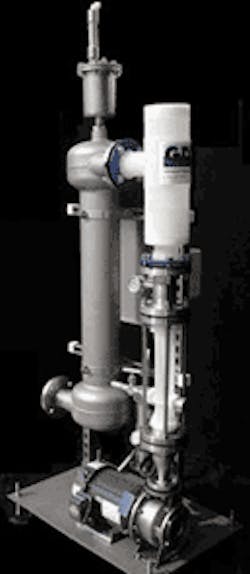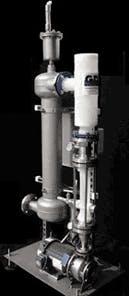New System Offers Ozone Disinfection of Municipal Water Distribution Pipelines
Water quality leaving treatment plants of North American water utilities is exceptional. Sadly, on the way to customers this safe, high quality potable water may become contaminated in the distribution system.
After two years of research by Denver Water and Camp Dresser and McKee (CDM) a new process to disinfect pipelines using ozone as the disinfectant is being employed in real world daily operation. The patent-pending Rapid Pipe Disinfection system uses mass transfer and degas technology from Mazzei Injector-GDT Corp. and Floating Plate air-cooled ozone generating technology from Pacific Ozone Technology.
The new ozone system can disinfect a pipeline in one hour, unlike traditional methods using chlorine that can take up to 24 hours.
Over the years, Denver Water has used continuous chlorine feed or slug dosing of chlorine to disinfect larger mains (12 to 108 inches), and calcium hypochlorite tablets for smaller mains (2 to 12 inches), in accordance with AWWA Standard C651.
A few years ago Denver Water and consultant Camp Dresser and McKee (CDM) began investigating dissolved ozone as a pipeline disinfectant. Denver Water conducted an extended pilot system evaluation on 4 to 6 inch pipelines based on positive results from small-scale laboratory ozone disinfection studies. In 2003 Denver Water assembled a mobile, trailer mounted ozone system for use on 6 to 12 inch pipelines.
The trailer mounted ozone system receives water from a local fire hydrant using fire hose. Ozone is produced from pressurized oxygen cylinders by an air-cooled 180 g/h Pacific Ozone Technology ozone generator and is added to the hydrant water using a packaged pressurized GDT ozone mass transfer system. More than 90% of the ozone gas is dissolved in the GDT process with off-gas discharged through an ozone destruct unit.
A pressure regulator controls inlet pressure to the trailer resulting in ozonated water flows between 200 and 260 gpm, depending on line size, with maximum applied dosages of 4 and 3 mg/L respectively. The high ozone residual at the entrance to the pipeline reacts with organisms and decays as it moves down the pipeline before discharge to the sewer at approximately 0.1 ppm, which is neutralized by ascorbic acid for discharge.
The concentration x time (Ct) value at the end of pipe is the monitored value for pipeline disinfection. By using the end of pipe value it is assured that higher disinfection will occur earlier in the pipeline that is exposed to a higher dissolved ozone level (C) for the same time (t).
The ozone trailer is typically operated for 30 minutes. The residual ozone in the pipeline is either allowed to naturally convert to oxygen (less than 1 hour) or is simply flushed with hydrant water over ascorbic acid tablets before sampling.
Denver Water has been tracking operational results of both the ozone and chlorination-dechlorination disinfection systems on 6 to 12 inch mains with runs up to 6,000 feet for almost two years. They have found first pass success rates to be virtually identical at 87%.
Ozone has been effectively employed for pipe disinfection/clean-in-place (CIP) in the food, beverage, pharmaceutical, cosmetics and electronics industries for many years. Denver Water’s testing has shown trailer mounted ozone treatment is a strong and viable alternative to chlorination-dechlorination practice for municipal main/pipeline disinfection.
For more information on the Rapid Pipe Disinfection system, contact Brian Johnson, President, Pacific Ozone Technology at [email protected] or Paul K. Overbeck, President, Mazzei Injector - GDT Corp. at [email protected]. WW


